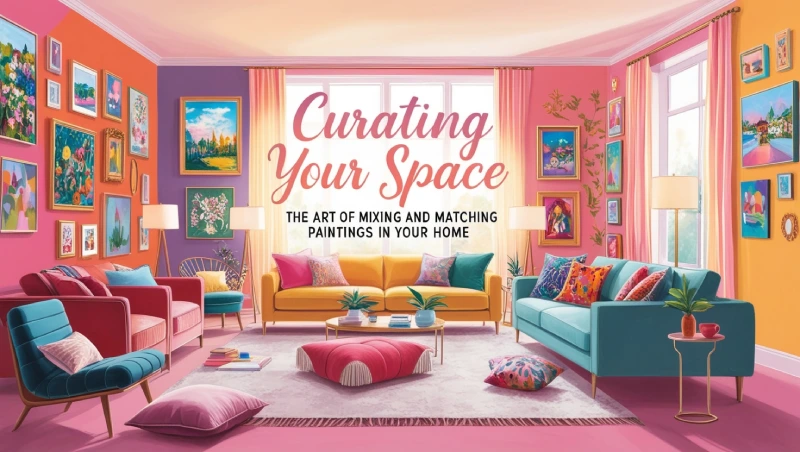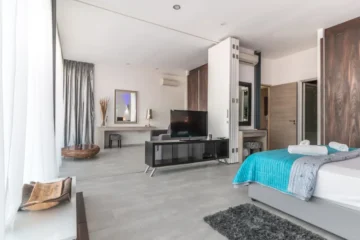Art has the power to transform any space, adding personality, depth, and character to a room. However, curating a collection of paintings that complement each other while enhancing your home’s aesthetic can be a challenge. Mixing and matching paintings is an art form in itself—one that balances colors, styles, themes, and frames to create a cohesive look.
In this guide, we’ll explore how to curate your space effectively with artwork, whether you’re decorating a living room, bedroom, or home office.
1. Understanding Your Aesthetic Vision
Before selecting paintings, define your home’s aesthetic. Are you aiming for a modern, minimalist feel, or do you prefer a bohemian, eclectic look? Understanding your interior style will help you choose artwork that enhances the space rather than clashing with it.
Consider These Design Styles:
- Minimalist: Neutral tones, simple compositions, abstract art.
- Eclectic: Bold colors, mixed media, varied frame styles.
- Traditional: Classic paintings, ornate frames, timeless pieces.
- Bohemian: Free-spirited, nature-inspired, textured artworks.
- Modern Contemporary: Geometric shapes, sleek designs, oversized canvases.
Once you’ve identified your aesthetic, it becomes easier to mix and match paintings that align with your vision.
2. Balancing Colors and Themes
When mixing paintings, one of the key elements to consider is color harmony. A well-balanced color palette will create a seamless flow between different artworks.
Tips for Color Coordination:
- Stick to a consistent color scheme (e.g., earth tones, pastels, monochrome).
- Use a dominant color that appears in multiple paintings to tie them together.
- Contrast bold, vibrant pieces with softer, neutral works to create balance.
- If your furniture and décor are colorful, opt for paintings with complementary hues.
Similarly, choosing paintings that share a theme—such as landscapes, abstract patterns, or figurative art—helps unify the collection. If your artworks are vastly different, find a common element, like brushstroke style or subject matter, to maintain cohesiveness.
3. Mixing Different Art Styles for Depth
A well-curated art collection doesn’t have to be uniform. Mixing different art styles can create depth and intrigue in a space.
How to Combine Different Styles Successfully:
- Pair abstract art with realism to create an interesting contrast.
- Combine vintage paintings with modern art for a balanced mix of old and new.
- Mix photography prints with hand-painted canvases for diversity.
- Integrate black-and-white sketches with vibrant paintings to add a dynamic touch.
By playing with contrast and harmony, you can curate a space that feels intentional and curated rather than chaotic.
4. Creating a Gallery Wall for Visual Impact
One of the most effective ways to mix and match paintings is by arranging them into a gallery wall. A gallery wall allows you to showcase multiple pieces without overwhelming the space.
Steps to Create a Stunning Gallery Wall:
- Select a focal point – Choose a main piece to anchor the collection.
- Plan the layout – Arrange artworks on the floor first to find the right composition.
- Use uniform spacing – Keep an even distance between frames to maintain balance.
- Mix sizes and orientations – Combine large and small paintings for a dynamic display.
- Experiment with frames – Mix frame styles, or opt for a consistent look with matching frames.
A well-executed gallery wall not only enhances the décor but also tells a visual story of your artistic taste.
5. Considering Texture and Mediums
Artwork comes in various forms, from traditional oil paintings to textured mixed media. Mixing different textures can add depth to a room.
Texture Mixing Ideas:
- Pair smooth glossy prints with rough-textured canvas paintings.
- Incorporate rolled canvas art prints for a modern, frameless look.
- Add metallic elements or 3D artwork for a striking contrast.
- Use fabric wall hangings alongside traditional paintings to soften the space.
By blending different textures and materials, you can make your art collection more engaging and tactile.
6. Choosing the Right Placement for Maximum Impact
Even the most stunning paintings can lose their impact if they’re not placed correctly. Consider the size of your space, furniture arrangement, and natural lighting before hanging your art.
Placement Tips:
- Hang artwork at eye level (about 57 inches from the floor) for optimal viewing.
- Position larger pieces above sofas, beds, or mantels to create a focal point.
- Use vertical paintings in narrow spaces and horizontal artworks for wide walls.
- Consider the lighting – Place paintings where natural or artificial light enhances their details.
Thoughtful placement ensures that your paintings complement the room rather than clutter it.
7. Refreshing Your Space with Art Rotation
Just like fashion, interior décor evolves with the seasons. One way to keep your home feeling fresh is by rotating your paintings periodically.
How to Rotate Art Effectively:
- Store extra pieces safely and swap them out seasonally.
- Use different frames or matting to give paintings a new look.
- Reconfigure gallery walls by rearranging existing pieces in a new layout.
Rotating art allows you to enjoy different pieces without committing to one static look year-round.
Final Thoughts
Curating your space with a mix of paintings is a creative way to express your personality and enhance your home’s ambiance. By balancing colors, themes, and textures while thoughtfully arranging your pieces, you can create a space that is both visually captivating and deeply personal.Whether you’re investing in original paintings or exploring rolled canvas art prints, the key is to curate with intention. With a thoughtful approach, your home can become a true reflection of your artistic style.




